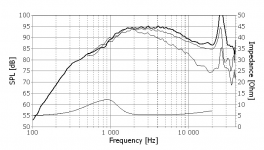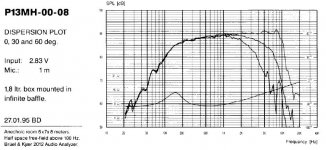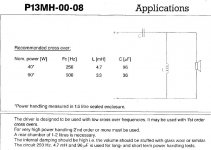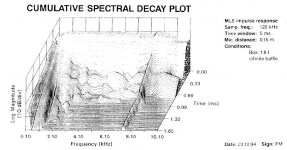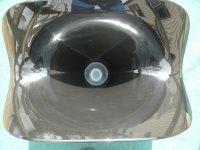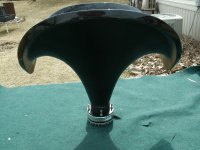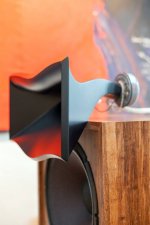This is the tweeter :
H1499-06 27TBCD/GB-DXT
It is somewhat surprising the DXT is rarely seen in commercial designs, with Bruno's (Putzeys) Kii being an exception.
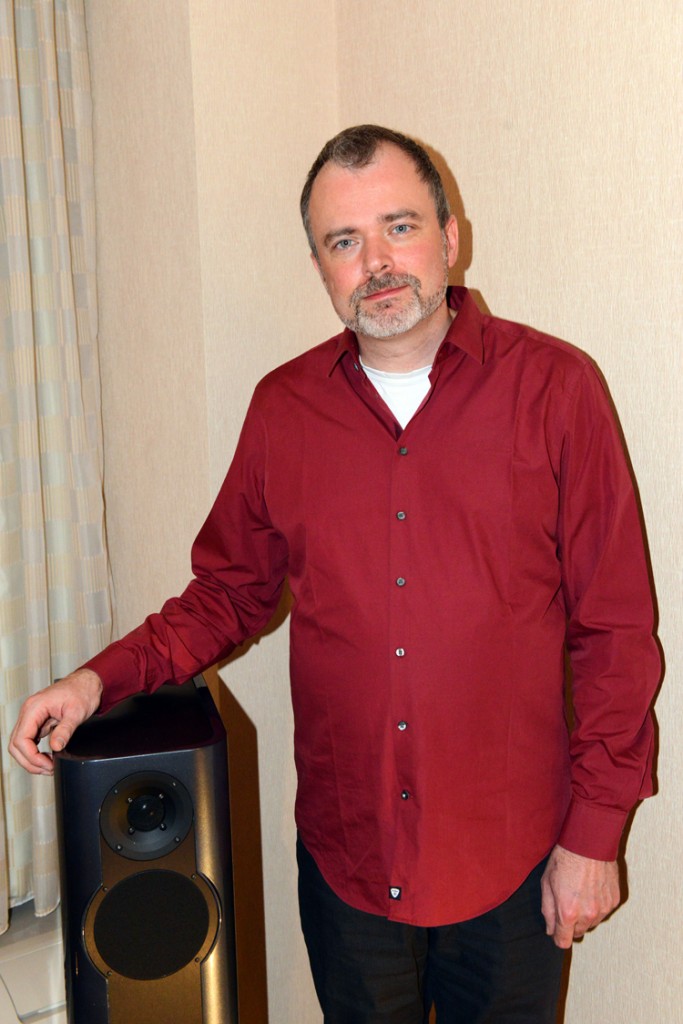
(How) did you deal with that huge breakup spike?
Attachments
Last edited:
I think the Kii has a Beryllium dome. Maybe it was the latest version of the Grimm LS1 that had it. Last year the Grimm was the best speaker in the world and now it is the Kii.Sorry, do not get that ********, i am confused. I heard both speakers at length in various locations and did not get nervous at all. I do not deal with the peak.
First i can not hear 27kHz and second i mostly listen to a 44kHz diet.
The ocasional High Res ? Sure, but in general i think recording is more important then medium nowerdays.
Could simply use a notch filter if i wanted. This is possible passive and also in DSP so where is the deal ? Call me incompetent as it happed here many times. Difference is that when i make a mistake i see it on my bank account. I mean i do not see it.
First i can not hear 27kHz and second i mostly listen to a 44kHz diet.
The ocasional High Res ? Sure, but in general i think recording is more important then medium nowerdays.
Could simply use a notch filter if i wanted. This is possible passive and also in DSP so where is the deal ? Call me incompetent as it happed here many times. Difference is that when i make a mistake i see it on my bank account. I mean i do not see it.
I do not deal with the peak.
First i can not hear 27kHz and second i mostly listen to a 44kHz diet.
The ocasional High Res ? Sure, but in general i think recording is more important then medium nowerdays.
Amen!
Dynamics
Ultimately, I agree (of course).
However, I also think that most people believe that all good (read: proper hi-fi and not PA) speakers must have severely compromised (read: poor) dynamics because they have never heard a well-designed and truly high-end horn-loaded system.
And no, 70+ year old Klipschorns and Altec Model 19 or VOT systems are not what I have in mind.
Nor are the various Avantgard, Cessaro, etc. multiple-round horn loudspeakers that some people may have heard at hi-fi shows what I consider particularly well-designed systems (they suffer from obvious integration issues, among other things).
Simpler 2-way or 'augmented 2-way' systems with 15" woofer(s) + horn-loaded large format compression drivers are where it's at, in my humble opinion.
Alas, with the caveat, though, that really good examples of this breed, using top-notch components and well-designed crossovers, are as rare as hen's teeth!
The only examples that come to mind (and all of which I have been lucky enough to listen to extensively, and study the design of) are:
- The large Pioneer Exclusive studio monitors from the '80s (using TAD AlNiCo woofers and Be compression drivers + wooden radial horns).
- The similar Rey Audio 'RM' studio monitors (which are the brainchild of the same engineer and use the same drivers).
- The G.T. Sound systems (which use slightly modified versions of the outstanding but short-lived Sony 'SUP' drivers of the '90s).
...and to prove that I do put my money where my mouth is, here are my own DIY speakers, directly inspired and informed by these projects.
Marco
I, fortunately, don't have to make a living from this. What I do know, is that all speakers are compromise.
We get live bands, discos and brass bands and orchestras at work. There is absolutely nothing that can compare to the sound of live acoustic instruments in a big hall. Such dynamics!
Ultimately, I agree (of course).
However, I also think that most people believe that all good (read: proper hi-fi and not PA) speakers must have severely compromised (read: poor) dynamics because they have never heard a well-designed and truly high-end horn-loaded system.
And no, 70+ year old Klipschorns and Altec Model 19 or VOT systems are not what I have in mind.
Nor are the various Avantgard, Cessaro, etc. multiple-round horn loudspeakers that some people may have heard at hi-fi shows what I consider particularly well-designed systems (they suffer from obvious integration issues, among other things).
Simpler 2-way or 'augmented 2-way' systems with 15" woofer(s) + horn-loaded large format compression drivers are where it's at, in my humble opinion.
Alas, with the caveat, though, that really good examples of this breed, using top-notch components and well-designed crossovers, are as rare as hen's teeth!
The only examples that come to mind (and all of which I have been lucky enough to listen to extensively, and study the design of) are:
- The large Pioneer Exclusive studio monitors from the '80s (using TAD AlNiCo woofers and Be compression drivers + wooden radial horns).
- The similar Rey Audio 'RM' studio monitors (which are the brainchild of the same engineer and use the same drivers).
- The G.T. Sound systems (which use slightly modified versions of the outstanding but short-lived Sony 'SUP' drivers of the '90s).
...and to prove that I do put my money where my mouth is, here are my own DIY speakers, directly inspired and informed by these projects.
Marco
Marco, I largely agree on your statements above.
My personal preferences are similar to yours and I will expand on these classic big 2 way systems later.
This is part of the trade off between large cabs with big drivers and smaller, more WAF approved designs. Earlier in this thread, I made a comparison between JBL's M2 vs. The Revel Ultra Salon 2.
Due to the laws of physics there's still no substitute for cubic inches in the Audio world.
Despite universal praise from the audio press, Bruno has acknowledged the limitations of the Kii Three due to the physical constraints. Many active powered, dsp controlled drivers in a rather small enclosure still 'won't take you there' > A large scale live performance.
My personal preferences are similar to yours and I will expand on these classic big 2 way systems later.
This is part of the trade off between large cabs with big drivers and smaller, more WAF approved designs. Earlier in this thread, I made a comparison between JBL's M2 vs. The Revel Ultra Salon 2.
Due to the laws of physics there's still no substitute for cubic inches in the Audio world.
Despite universal praise from the audio press, Bruno has acknowledged the limitations of the Kii Three due to the physical constraints. Many active powered, dsp controlled drivers in a rather small enclosure still 'won't take you there' > A large scale live performance.
Last edited:
I always prefer discos with line arrays rather than the usual old MT active speaker.
From my experience: it depends on many things > the room (acoustics), proper installation, in house sound engineering, the (lack of) skills of the artist(s) etc.
On a regular basis I visit a large music centre in which several theatres, clubs, studio's etc. are based.
In one of the smaller rooms - with a fixed Installation of db elektroakustik array modules - the sound quality is exceptional. Well balanced, not too loud, clear, smooth etc.
The larger room downstairs also features a line array with - depending on the program and amount of visitors - some extra infill speakers.
There is a huge difference in sound quality between these two spaces. The latter is mediocre at best.
Tony Andrews, founder of Funktion-One and TurboSound has always been a proponent of full range PA systems. While many of this man's statements on audio technology seem to resemble marketing more than science, I have to admit: a proper Funktion-One installation or live PA is (still) something special.
Anybody who has ever been to Berghain in Berlin, very early in the evening - during warm up -, may have experienced what I refer to.
Last edited:
I think the Kii has a Beryllium dome. Maybe it was the latest version of the Grimm LS1 that had it. Last year the Grimm was the best speaker in the world and now it is the Kii.
According to a Dutch Kii dealer, the SEAS DXT in the Kii Three appears to be a standard $70 unit without the Beryllium dome of the Grimm LS-1. With the aid of the very advanced SHARC DSP inside the Kii Threes, any flaw of these drivers can be fixed (delay issues due to the DXT WG, the break up/ringing of the alu dome etc.), except for the sound signature of the materials > Aluminium vs. Beryllium.
Perhaps because of the latter, there is some controversy about the use of this tweeter in such an advanced loudspeaker system.
Last edited:
Some people prefer these to the Kii's...
An externally hosted image should be here but it was not working when we last tested it.
We are getting a bit scattergun here, IMO. So many different ideas! 
I was examining the Funktion-One PA ideas: Funktion-One
Roy Allison said you must consider the room for a speaker. For PA, you must consider where the audience sits too.
I didn't find anything terribly convincing in Tony Andrews' ideas about multiple point sources splayed out to each listening area. He's actually mixing it up with subwoofers, line array midrange and horizontal horn tweeters.
His midrange units are actually horn-loaded arrays of midrange cone units. He feels these produce a better sound than a horn-loaded dome up to 8kHz, where a compression driver can take over for a whacking high frequency transient.
I'm starting to think we should separate the bass below the bafflestep point, the midrange below the combing or dispersion limiting point, and the treble where it becomes hard to locate. Oh wait. Maybe I agree with Tony Andrews!
Apropos nothing, here's a near perfect Vifa 5" P13MH-00-08 polycone midrange driver that Lynn Olson will relate to, being the midrange version of his Ariel driver. But observe how it goes to pieces at about 7kHz. You don't need a waterfall to know that. The steep rolloff tells you that. Which is why I think the SEAS DXT tweeter has something going for it. A very gentle curve.
I was examining the Funktion-One PA ideas: Funktion-One
Roy Allison said you must consider the room for a speaker. For PA, you must consider where the audience sits too.
I didn't find anything terribly convincing in Tony Andrews' ideas about multiple point sources splayed out to each listening area. He's actually mixing it up with subwoofers, line array midrange and horizontal horn tweeters.
His midrange units are actually horn-loaded arrays of midrange cone units. He feels these produce a better sound than a horn-loaded dome up to 8kHz, where a compression driver can take over for a whacking high frequency transient.
I'm starting to think we should separate the bass below the bafflestep point, the midrange below the combing or dispersion limiting point, and the treble where it becomes hard to locate. Oh wait. Maybe I agree with Tony Andrews!
Apropos nothing, here's a near perfect Vifa 5" P13MH-00-08 polycone midrange driver that Lynn Olson will relate to, being the midrange version of his Ariel driver. But observe how it goes to pieces at about 7kHz. You don't need a waterfall to know that. The steep rolloff tells you that. Which is why I think the SEAS DXT tweeter has something going for it. A very gentle curve.
Attachments
Last edited:
I also think that most people believe that all good (read: proper hi-fi and not PA) speakers must have severely compromised (read: poor) dynamics because they have never heard a well-designed and truly high-end horn-loaded system.
And no, 70+ year old Klipschorns and Altec Model 19 or VOT systems are not what I have in mind.
Nor are the various Avantgard, Cessaro, etc. multiple-round horn loudspeakers that some people may have heard at hi-fi shows what I consider particularly well-designed systems (they suffer from obvious integration issues, among other things).
Simpler 2-way or 'augmented 2-way' systems with 15" woofer(s) + horn-loaded large format compression drivers are where it's at, in my humble opinion.
Alas, with the caveat, though, that really good examples of this breed, using top-notch components and well-designed crossovers, are as rare as hen's teeth!
The only examples that come to mind (and all of which I have been lucky enough to listen to extensively, and study the design of) are:
- The large Pioneer Exclusive studio monitors from the '80s (using TAD AlNiCo woofers and Be compression drivers + wooden radial horns).
- The similar Rey Audio 'RM' studio monitors (which are the brainchild of the same engineer and use the same drivers).
- The G.T. Sound systems (which use slightly modified versions of the outstanding but short-lived Sony 'SUP' drivers of the '90s).
...and to prove that I do put my money where my mouth is, here are my own DIY speakers, directly inspired and informed by these projects.
Marco
And these are real studio monitors, installed in top-line recording studios around the world. Very different than the audiophile speakers at the usual hifi shows. Thanks for the links, Marco!
Those Yuichi horns do look remarkably similar to this:

Yes, they are similar. Wooden hypex (T=0.6~0.7) radial horns with a ~300Hz cut-off frequency.
Which horn is that? I'd never seen it before.How about something like this for a big 2 way?

The Funktion-One 'Tops' are hornloaded and use phase plugs for the mid/lows.
Baffle step is hardly an issue in PA. Infrasubs are used for low freq duties.
The difference between "monitors" and PA speakers is their "throw". Monitors are for near-field use. Most PA Speakers (array or full range) are designed for medium and long throw purposes, which is not necessarily the same as mid and far field.
Phenomena like "beam steering" come into play, especially with waveguided array modules. This may be translated with "controlled dispersion", but that's beyond the scope of this thread.
Baffle step is hardly an issue in PA. Infrasubs are used for low freq duties.
The difference between "monitors" and PA speakers is their "throw". Monitors are for near-field use. Most PA Speakers (array or full range) are designed for medium and long throw purposes, which is not necessarily the same as mid and far field.
Phenomena like "beam steering" come into play, especially with waveguided array modules. This may be translated with "controlled dispersion", but that's beyond the scope of this thread.
Last edited:
If the setup is messed up > bad post processing, added processors, bad EQ, etc. etc. the sound will indeed be horrible.
As far as I know F1 uses FANE and Beyma drivers, nothing wrong with these.
Even with todays advanced DSP like Dante etc. PA sound requires some know how to get right. Funktion One and similar PA systems (VOID ao.) are fairly straightforward, but less suitable for large scale (long throw) venues. For large scale PA it would make sense to choose l'Acoustics, NEXO, D&B or similar.
As far as I know F1 uses FANE and Beyma drivers, nothing wrong with these.
Even with todays advanced DSP like Dante etc. PA sound requires some know how to get right. Funktion One and similar PA systems (VOID ao.) are fairly straightforward, but less suitable for large scale (long throw) venues. For large scale PA it would make sense to choose l'Acoustics, NEXO, D&B or similar.
Last edited:
Yes, they are similar. Wooden hypex (T=0.6~0.7) radial horns with a ~300Hz cut-off frequency.
Which horn is that? I'd never seen it before.
I guess this is a custom design, based on existing horn profiles (Iwata, Klipsch/Vitavox etc.) with the angled throat inpired from the WE KS-12024 and optimized with nummerical modelling in COMSOL or ANSYS.
The "lips" look kind of familiar though.
Attachments
Last edited:
I guess this is a custom design, based on existing horn profiles (Iwata, Klipsch/Vitavox etc.) with the angled throat inpired from the WE KS-12024 and optimized with nummerical modelling in COMSOL or ANSYS.
Cool, thanks.
But what would be the advantage (if any) of that first curved section near the throat?
M.
- Home
- Loudspeakers
- Multi-Way
- Classic monitor designs?
